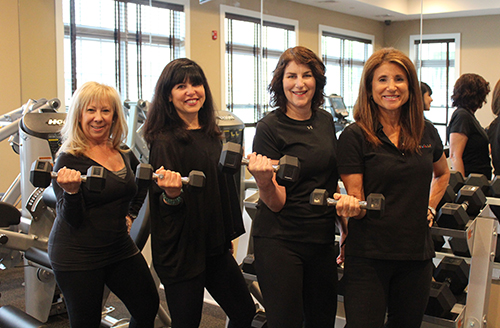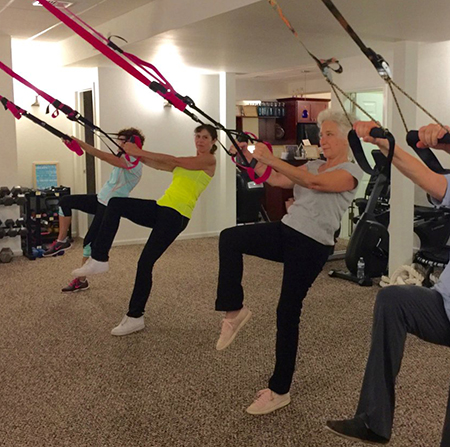Health + Medicine
Feature
Cancer Recovery Prescription—Exercise

Janet Rubin was diagnosed with breast cancer in 2009 and soon after underwent a bilateral mastectomy. She then had TRAM flap reconstruction, where the surgeon used a section of her skin, fat and abdominal muscle to reconstruct her breasts. While she was recovering from the second surgery, “everything hurt,” Rubin said. It was “like being hit by a bus.” But instead of remaining sedentary, Rubin chose to exercise.
At first, Rubin, who lives in Short Hills, N.J., could only walk half a block before getting winded. But she kept walking short distances several times a week on the track of her local Jewish community center and in her own neighborhood. An unfortunate side effect of TRAM flap surgery is a loss of range of motion due to deep cuts in the abdominal muscles. It was crucial, therefore, to add stretching and leg and arm lifts to her workouts as soon as she could, about three months after surgery.
Ten years later, the 62-year-old is happy to report that exercise has helped her get much of her range of motion and strength back. “I do almost everything now,” Rubin said, noting that her current exercise routine consists of stretching, core strengthening, spin classes, Zumba and weight training.
Judy Kahn, 67, of Holmdel, N.J., was an avid tennis player before her breast cancer diagnosis and subsequent lumpectomy and lymph node removal. After the surgery, she, too, had limited range of motion in one of her arms. “My doctor was very emphatic about the fact that exercise prevents cancer recurrence,” she said. She signed up for a group exercise class for postoperative patients at her hospital as well as one-on-one classes with an exercise specialist. Within a couple of months, she was back on the tennis court. Her exercise classes “really helped me to get back to a normal life,” she said.
Rubin and Kahn are two of the many cancer survivors who have experienced physical and mental benefits from exercising after completing cancer treatment. Both women have trained with Carol Michaels, an exercise specialist in cancer recovery who works in West Orange, N.J., and Palm Beach, Fla.
Exercise has “tremendous benefits” for cancer survivors, said Michaels, a consultant, lecturer and educator who recently published Exercises for Cancer Survivors, based on her fitness program. The clear physical and mental benefits of exercise are what prompted Michaels to begin her Cancer Recovery Fitness program over 20 years ago.
 Cancer is currently the second leading cause of death in the United States, and the leading cause of death in Israel. The number of new cancer cases per year is expected to rise to 23.6 million by 2030, according to the National Cancer Institute. Advances in cancer treatments mean that more people are surviving their diagnoses than ever before. Yet these survivors often experience life-altering side effects from the disease and the harsh treatments they must endure, including surgery, chemotherapy and radiation.
Cancer is currently the second leading cause of death in the United States, and the leading cause of death in Israel. The number of new cancer cases per year is expected to rise to 23.6 million by 2030, according to the National Cancer Institute. Advances in cancer treatments mean that more people are surviving their diagnoses than ever before. Yet these survivors often experience life-altering side effects from the disease and the harsh treatments they must endure, including surgery, chemotherapy and radiation.
Exercise as a path to a healthy recovery “seems counterintuitive, doesn’t it?” said Dr. Michelle Holmes, a cancer epidemiologist at Harvard Medical School and the Harvard T.H. Chan School of Public Health, who studies lifestyle impacts on breast cancer survival. But exercise can indeed help battle fatigue and other symptoms caused by cancer treatment. “Exercise seems to help with mood, depression, quality of life, fatigue, avoiding weight gain, muscle aches and pains that can come with hormonal treatments.” A further complication for some women with breast cancer is taking hormone-suppressing drugs, such as anastrozole, which can cause loss of bone mass. Exercise can help relieve that side effect, too.
It will even help some cancer survivors live longer. In 2005, Dr. Holmes co-authored a study in JAMA that found that women who walked three to five hours a week after breast cancer diagnosis had a reduced risk of death from breast cancer. Other researchers have published similar findings. Exercise has been found to lower the risk of death from colorectal cancer and prostate cancer and has been shown to improve quality of life for survivors of many other cancers, among them lymphoma and lung cancer.
Doctors don’t know exactly why exercise works wonders for cancer survivors, said June M. Chan, a professor of epidemiology and biostatistics as well as urology at the University of California, San Francisco. But, she said, there are some hypotheses. In 2011, Chan and her colleagues published a study in the Journal of Clinical Oncology that found that men diagnosed with prostate cancer who engaged in vigorous exercise for three or more hours a week experienced a 61 percent lower risk of death from the disease compared to men who exercised less than one hour a week. In these men, exercise might be linked to improved regulation of insulin and growth hormones, among other benefits. Exercise may also have an anti-inflammatory effect. But, she said, “it’s very hard to tease apart” all the effects of exercise on the body.
Then there is the psychological benefit of exercise. “There are natural endorphins that are released when someone exercises,” said Chan, “so it will definitely help someone feel better mood-wise.”
It helps, said Michaels, the specialist in the field, that exercise classes for cancer patients and survivors tend to be warm and inclusive environments. “It’s a place where people can feel comfortable no matter what they look like,” she said. “They don’t have to put their wig on.”
After being diagnosed with endometrial cancer, Rita Stringer, 70, underwent a total hysterectomy, vaginal radiation and had 36 lymph nodes removed. During her recovery, exercise “helped healing physically, but also emotionally,” said the Holmdel, N.J., resident. The class was “its own support group, in a way, because all of you are working on this together.”
Stringer also started taking long, meditative walks where she focused on the sights, sounds and beauty of nature. “Walking is one of the best ways for me, psychologically, to relieve stress,” she said.
Michaels, who offers private classes as well as group sessions at hospitals and fitness centers, said that “when people are stressed or depressed, their tolerance for pain is less.”
Michaels’ classes include stretches and strength training exercises specifically formulated to help rehabilitate cancer survivors. “Each chemo and each different type of operation results in different side effects that you need to understand to create the proper exercise program,” said the award-winning certified personal trainer.
Beyond Michaels’ program, there are hospitals that offer their own classes for cancer survivors. The YMCA, in partnership with LIVESTRONG, also offers free and low-cost fitness classes for survivors at more than 700 locations. Other resources can be found on the American Cancer Society website, and at breastcancer.org.
You can also start by asking your doctor what programs are offered in your area.
Despite proven successes, Michaels said that “there’s still a long way to go” to assure accessible exercise classes for cancer survivors. There aren’t enough trainers who are knowledgeable about the specific needs of cancer patients, she said. That’s why she created a training course for cancer recovery specialists now offered by the National Federation of Professional Trainers.
“Cancer exercise programs should be as fundamental in the care of cancer patients as surgery, chemotherapy and radiation,” Michaels said. For now, though, her main goal is to “help everyone have a better recovery.”
Best Types of Exercises for Cancer Recovery
Adapted from Exercises for Cancer Survivors by Carol Michaels
1. Stretching increases range of motion and muscle elasticity, improves circulation and helps the body repair itself.
2. Strength training strengthens many different parts of the body, including tendons and ligaments as well as builds bone and muscle mass.
3. Balance training can help those with less bone mass to regain mobility and strength and prevent dangerous falls and broken bones.
4. Moderate aerobic exercise—brisk walking, swimming, cycling or running—for at least 150 minutes each week is recommended by the American Cancer Society.
Leah Rosenbaum writes about health care and science.










 Facebook
Facebook Instagram
Instagram Twitter
Twitter
Susan Levy says
Excellent article. I’m lucky enough to attend a work out program for women who have gone through breast or gynecological cancers. We have an amazing trainer who modifies our workout for each of our needs but pushes us too. In addition to the three mornings a week in the gym there is also a nutrition lecture, meeting with a counselor and a yoga session. We are called Extra Toughs.
Naomi Herman says
Check out breast cancer survivor dragon boat teams in your community. For the past 13 years, it has been the best non-support support group for me. Teams are open to survivors of all ages and athletic ability. Fun, exercise, teamwork, camaraderie.
Madeline Calahan says
Thank you, Leah, for sharing Rubin’s inspiring story on how she recovers from breast cancer. It is really a helpful guide for a cancer survivor who wants to return to their active life.